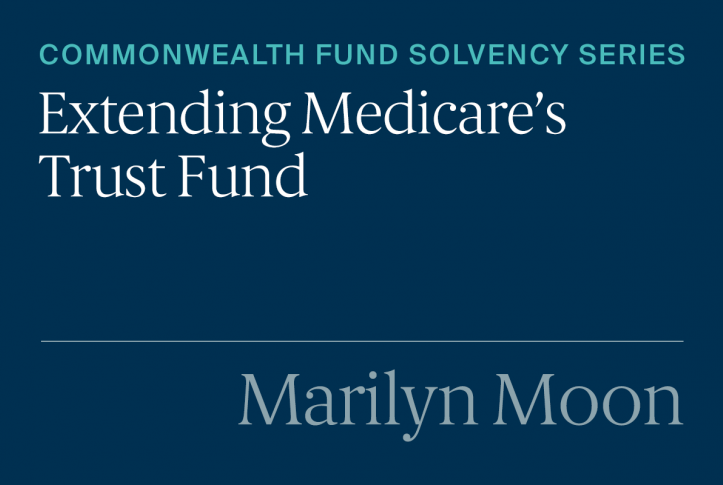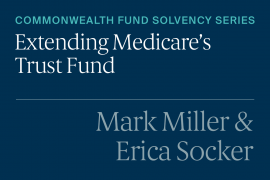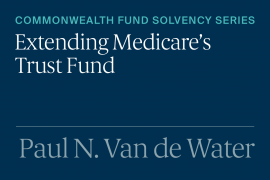The Medicare Hospital Insurance (HI) Trust Fund, which pays for Medicare beneficiaries’ hospital bills and other services, is projected to become insolvent in 2031. Without changes to expected spending or trust fund revenue, the trust fund will not have sufficient funds to cover the entire cost of beneficiaries’ health care. The HI trust fund is primarily funded through payroll taxes paid by employers and employees, with some additional income from interest as well as premiums paid by voluntary enrollees not automatically entitled to Medicare Part A. Will the trust fund solvency be extended by reducing the projected growth in expenditures, raising revenues, changes to the services covered by Medicare Part A, or a combination of these options
To stimulate policy discussions, the Commonwealth Fund asked a group of Medicare thought leaders with a variety of backgrounds and political affiliations to outline how they would extend the life of the trust fund. This series presents their perspectives, highlighting areas of commonality while also putting forth some new ideas for addressing this pressing issue.
New Revenue Sources Needed
Medicare has been a major success: improving the health of our most vulnerable citizens through access to mainstream medical care. And, it has often been a leader in reducing excess health care spending. Certainly, Medicare can and should find places to save, for example by reducing payments to private Medicare Advantage plans, which have been shown to exceed the costs of traditional Medicare. But such efforts may bring only modest savings.
Further, efforts to find savings should not include cuts in beneficiaries’ benefits or substantial premium increases. Beneficiaries are already bearing a substantially higher burden for the costs of a more modest benefit package than in the past. This share will continue to rise as older workers remain in the labor force longer and pay a greater share of payroll and income taxes. The pandemic is also raising Medicare’s costs and could continue to do so if some beneficiaries develop long-term health problems from the coronavirus.
Thus, it is important to consider new sources of revenue for Medicare, something that has been avoided except for piecemeal efforts for many years. The basic payroll tax rate that funds Part A of Medicare has remained constant since 1987 despite a doubling of the population served and a doubling of per capita spending. There have been some changes, including the elimination of the cap on the amount of wages subject to tax, which has been consequential in raising revenue and has made the payroll tax more progressive. Further, the addition of high-income assessments for Medicare premiums and taxes and the increased role of general revenues in funding have made the program’s financing more progressive and thus has created an opportunity to modestly raise the payroll tax rate.
The Part A trust fund could be shored up solely by increasing the payroll tax. Even small rate increases could generate substantial revenue because the tax is broad-based. And it is a relatively popular tax since it is earmarked for Medicare. But this should not be the only action taken. It will be important not to rush to raise taxes on workers who have suffered so much from the economic downturn, particularly since the recovery is likely to take some time. Consequently, I advocate a three-pronged approach for bolstering the Part A trust fund.
- First, require that people and corporations who benefitted from the pandemic share some of their windfall. For example, an “excess profits tax” could place a higher tax rate on income earned during 2020 and 2021 that exceeds 2019 income by a certain percentage. One need only compare the stock market gains with the wage declines of many workers to understand that the pandemic’s economic pain has not been equally shared across the economy. Creating such a temporary surcharge will require careful thinking about how to capture such excess fairly, but as a society, we should compensate those who have suffered, and what better way to do so than ask those who were fortunate enough to be in the “right” businesses. As Richard Thaler recently advocated in the New York Times, those with the most resources (e.g., professional athletes and corporate executives) — who are likely to find a way to jump the queue to receive COVID-19 vaccines — should be allowed to bid for vaccines in a charity auction. Some of the money raised could compensate disadvantaged workers, but some also could help bolster the health care system, including Medicare.
- One way of tapping into existing revenue would be to direct some or all the resources obtained from the net investment income tax (NIIT) assessed on high-income individuals into the Part A trust fund. Today, revenue from this tax goes into general revenues instead of financing Part A. Such a change would shift up to $350 billion over 10 years into Part A, alleviating much of the near-term shortfall.
- Finally, a modest payroll tax rate increase should be phased in starting in about two years. This would give workers time to recover and would, over time, provide a meaningful increase in contributions. If phased in gradually, it would not create large increases in tax burdens in any year and could provide support for Part A beyond the next 10 years. When Medicare was enacted, it was expected that payroll tax rates would need to rise over time to meet the needs of a growing population of older adults and pay for care that was likely to become more expensive. The payroll tax in combination with general revenue contributions would still represent a progressive funding stream. About $400 billion could be raised over 10 years with gradual increases to eventually reach a rate increase of about 1 percentage point (from 1.45% to 1.95% each for employees and employers). This is about half what would be obtained from an immediate increase.
The Medicare Part A trust fund was intended to warn policymakers when changes were needed to sustain this crucial program for future generations. It should spur a debate on how best to protect the program rather than as a mandate for cutting this crucial benefit as many critics of Medicare have claimed over the years.






